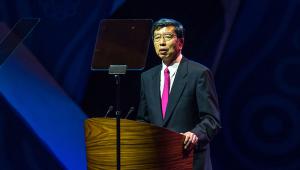In a review of the region’s infrastructure needs, the ADB estimated the total infrastructure bill for the region up to 2030 would be $22.6tn dollars, or $1.5bn annually. This figure rises to $26tn ($1.7tn annually) when climate change mitigation costs are included, more than double the bank’s 2009 estimate of $750bn.
The Meeting Asia’s Infrastructure Needs study considers the region’s power, transport, telecoms and water sanitation infrastructure requirements for the next decade and a half. It analyses current infrastructure stock and future needs, and the financing tools available to serve this.
Takehiko Nakao, president of the ADB, said that the demand for infrastructure across Asia and the Pacific far outstrips current supply.
He said: “Asia needs new and upgraded infrastructure that will set the standard for quality, encourage economic growth, and respond to the pressing global challenge that is climate change.”
The report noted that infrastructure development across the 45 countries covered in the study had grown dramatically in recent years, which has spurred growth, reduced poverty and improved people’s lives. However, it noted a “substantial infrastructure gap remains,” whereby more than 400 million people still lack electricity, 300 million lack safe drinking water and around 1.5 billion lack access to basic sanitation.
Also, many of the region’s economies lack critical trade infrastructure such as ports and railways that could allow them to access to greater local and international markets.
Nakao said: “ADB pledges to work with member countries and use our 50 years of experience and expertise to meet infrastructure needs in the region. As the private sector is crucial to fill infrastructure gaps, the ADB will promote investment-friendly policies and regulatory and institutional reforms to develop bankable project pipelines for public-private partnerships.”
Taking climate impacts into account, the region will need $14.7tn for power and $8.4tn for transport, up to 2030. Over the same period, telecoms investment will need to reach $2.3tn and water and sanitation costs will reach $800bn.
East Asia will account for the majority of total infrastructure need (61%), although as a percentage of GDP, the Pacific region will require the most investment, at 9.1%.
The inclusion of climate-related costs in the estimation partly explains why the figure announced today is almost double that predicted in 2009, the ADB said. Moreover, the rapid growth forecast for the region has pushed the estimate up, as has the inclusion of 45 ADB members (instead of the 32 in the previous report) and the use of current pricing.
Currently the region invests $881bn in infrastructure annually, which means the gap between need and demand is around 2.4% of GDP between 2016 and 2020. However, without China’s significant contribution, this gap rises to 5%.
The ADB said that public finance reforms could generate extra revenue to bridge 40% of the gap (2% of GDP) for the region.
In its recommendations, the ADB advised countries in the region to drive through regulatory and institutional reforms to make infrastructure more attractive to private investors. Also, greater collaboration between the state and businesses through public private-partnerships should be promoted, it said, through enacting laws and streamlining procurement and bidding processes.
Capital markets also need to be deepened, the ADB said, “to channel the region’s substantial savings into productive infrastructure investment.”













